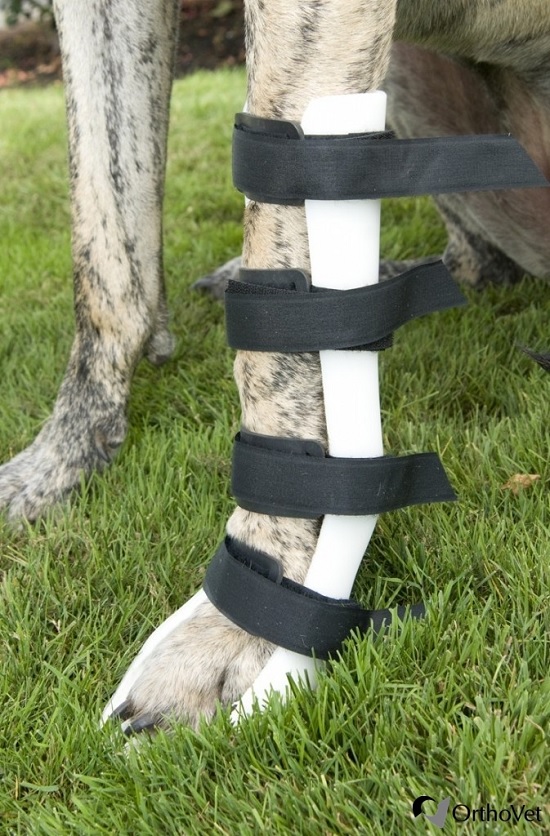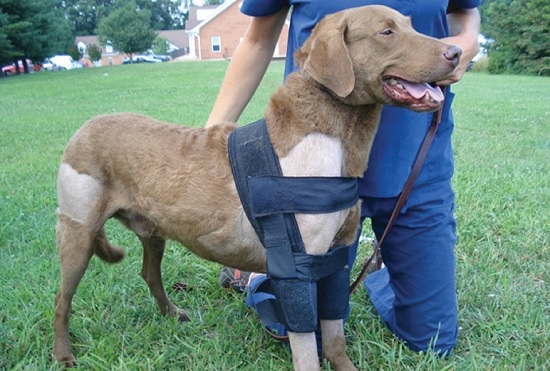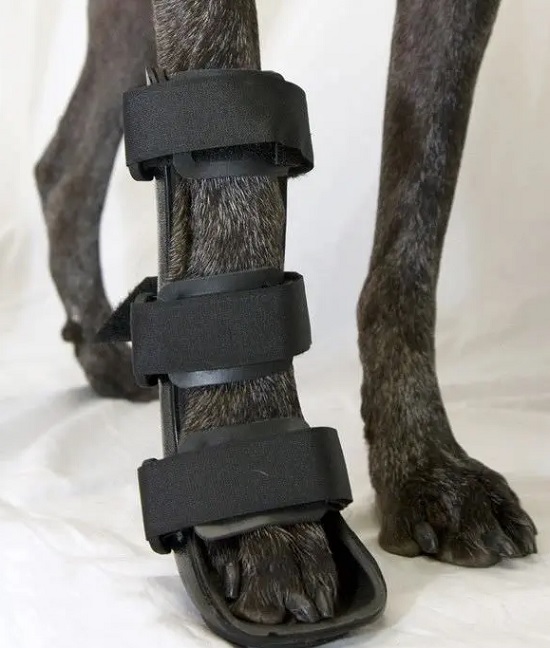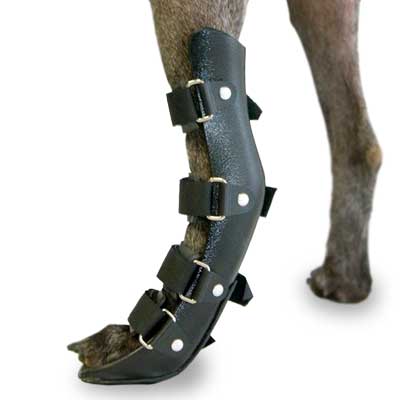Veterinary Canine Splints
Splinting Procedure on a Dog
A splint is a rigid material used to aid in immobilization and support of a not yet set bone or a fracture / sprain. The same materials used to construct casts can be used in splint creation, but thermal plastic is commonly used as it possesses the ability for reuse. Ready-made splints of plastic are also commonly used for fractures, and are easily applied.
Splinting
Splints are not total encircling devices, but aid in early immobilization when a fracture is accompanied by a great deal of swelling.
there are a number of different splints that are ready made, but sometimes the vet will need to custom make a splint from thermoplastic sheets.
For Splinting product line view below Right for Product links
Materials: Low-temperature thermoplastic sheets are heated, then custom moulded to match the exact contours and requirements of the animal. Velcro is usually used to secure the splint in place. The splint can be remolded if the needs or shape changes.
In splinting of a foreleg fracture, strips of plaster run down the cranial and caudal aspects, bound together by a tape or elastic gauze. Splint material is chosen according to the size of the dog and length of the limb. The strips are laid on the dressing table and plaster is made wet.
- The wet strips are placed on the affected leg, starting from the toe to the elbow.
- Uniform distance is maintained between the cranial and caudal aspects, then gauze is wrapped in a circular motion around the plaster.
- The splint is flexed to conform to the natural bend in the extremity and Velcro hook / loop tape is applied to hold it in place.
- V Tapes offer Vet Clinics the hook & loop strap which is available for ordering and with a pair of scissors can easily be cut down if the strap is too long.
- There is a strapping tape which is a quick and easy method of strapping called Qwik tie, this product is available in 12.5 mm, 20 mm and 25 mm widths. It provides a very efficient and cost effective attachment of the soft cast splint. Samples of all V Tapes products are available for testing purposes.

Using Canine Splints
Before using a splint it is important to make sure that the size is correct, a small splint will be too tight while a big one will dance around and not give proper support. The splints are made from thermo-deformable plastic, they can be heated and adapted to the dog, either widening or closing slightly. The angle should NOT be modified.
For maintenance and care using a damp cloth should be enough, or it is possible you may want to clean the outside carefully with brush. Using hot water and soap is not recommended, as the splint should not get too wet.
Placing the splint
The first times you put on the splint it is better if you have someone helping you to keep it in place or distract the dog.
We can put the splint on the forelimb with the dog sitting or standing (with the four limbs on the ground; putting the splint on with the dog lying down in the lateral decubitus or prone position is not recommended).
Hindlimb splints should be placed with the dog standing.
The dog’s skin should be clean and dry, it is very important that the skin is dry
because otherwise skin irritations, redness or small ulcers can appear.
Placing a tubular bandage or a cohesive elastic bandage around the dog’s leg is advisable. The role of this bandage is to increase comfort. Make sure it is not too tight, using it will make the dog tolerate the splint better.
The splint is placed on the back of the front leg leaving the velcro straps at the front. First place the dog’s paws in the bottom of the splint, leaving the fingers relaxed, these should protrude from the splint.
Place the front protective straps so that they fall right in the middle of the front of the dog’s paw for more comfort. First adjust the lower leg velcro making sure that the dog’s leg is completely adjusted to the splint, then adjust the middle strap and finally the top.
Unless your vet has indicated otherwise, the dog should not wear the splint all day long, normally at night the dog can sleep without it and during the day we will mainly use it during times of increased exercise. For certain neurological problems or after fissures or fractures, with the advice of your vet, they may be indicated for permanent use. In this last case we should regularly check the animal’s skin.



V Tapes are suppliers of the following materials for making splints and canine braces ++
V Tapes stock the following products ;
cohesive elastic bandages for splinting purposes
cotton elastic premium EAB tapes
Neoprene and EVA materials for the manufacture of splint material
low profile hook and loop tapes for fastening requirements of splints with or without adhesive backing
Special Formulated adhesive backed hook tapes that will adhere to soft cast splints, thermoplastic etc
Special custom made splint straps
Qwik tie Splint strapping tape for buddy strapping / splints etc
soft cushioning straps for holding dog to operating table or to provide padding for dogs comfort and post-surgery recovery
Plastic and metal buckles, rings and other hardware used in the manufacture of attaching the splint to the leg, as shown in the photos on this blog.

V Tapes offer Dog breeders fully adjustable breeding collars.
These unique Animal Breeding VELCRO® Brand ID Collars
Colours available ; Red, Orange, Yellow, Green, Blue, Purple
VELCRO® brand Breeding Collars are a must for anyone that is breeding or raising puppies, lambs or calves.
You just wouldn’t be without them once you had used them.
To find out more check out Animal ID Collars



